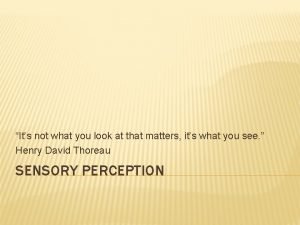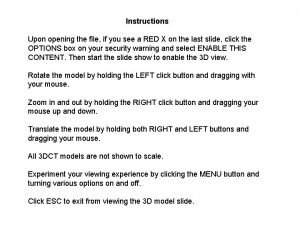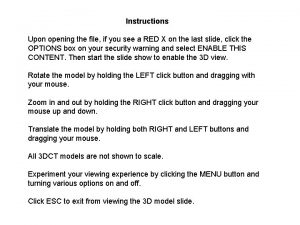Instructions Upon opening the file if you see



- Slides: 3

Instructions Upon opening the file, if you see a RED X on the last slide, click the OPTIONS box on your security warning and select ENABLE THIS CONTENT. Then start the slide show to enable the 3 D view. Rotate the model by holding the LEFT click button and dragging with your mouse. Zoom in and out by holding the RIGHT click button and dragging your mouse up and down. Translate the model by holding both RIGHT and LEFT buttons and dragging your mouse. All 3 DCT models are not shown to scale. Experiment your viewing experience by clicking the MENU button and turning various options on and off. Click ESC to exit from viewing the 3 D model slide.

The Smithsonian Institution’s Division of Mammals (http: //vertebrates. si. edu/mammals/) houses many lagomorphs in its scientific collections. This specimen, USNM 269083 (http: //collections. nmnh. si. edu/search/mammals/? irn=7154788), is a female amami rabbit (Pentalagus furnessi) from Japan. This individual was collected in 1906 by N. Kuroda on Amami-Oshima Island. The amami rabbit inhabits two small islands, Amami-Oshima and Toku-no-Shima, near the southern coast of Japan living in both mature and young forests. Acorn availability provided by the dense, mature forests enables year round resources as well as protection from predators like the mongoose. The perennial grasses in the younger forests provide nutrition for their diet used at different times of the year. Forest clearing and commercial logging is unfortunately removing these habitats. Current surveys report approximately 5, 000 specimens left on the two islands with only recent conservation acts like The Amami Wildlife Conservation Center, established in 1999, and a mongoose eradication program, established in 2005, to preserve these animals. This is a CT scan of the mandible of USNM 269083. These three-dimensional scans are made publicly available through the generous support of the Smithsonian 2. 0 Fund, provided from the annual gifts of the Smithsonian National Board to the Secretary to use at his discretion (http: //smithsonian 20. si. edu/fund. html), and the Smithsonian Collections Care and Preservation Fund. The main goal of this joint initiative between the Human Origins Program and the Division of Mammals is to make the NMNH's scientific collections of our closest living nonhuman primate relatives available in 3 D for education and research. These slides can be used for educational purposes only. For all other uses, please contact the Human Origins Program at HO-Photo. Request@si. edu or Human. Origins@si. edu






